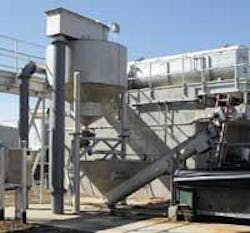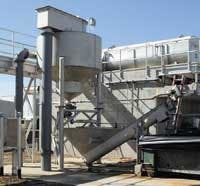Vortex Separator Removes Grit Down to 100 Microns Over Wide Turndown Range
Grit King medium-energy free vortex separators from Hydro International provide a solution for removing grit at the headworks of municipal treatment plants. The separators have no moving parts and use tangential feed to induce rotary motion within a circular chamber.
The system provides 95% removal of 100-micron particles with no loss in efficiency over a 4-1 turndown ratio. Head losses are typically less than 12 inches and the device is very compact, making it ideal for applications where space is at a premium.
Grit removal is one of the major challenges in operating municipal wastewater treatment systems. If grit is not removed early in the treatment process, it can cause premature wear and tear on pumps and mechanical components through abrasion. Grit entering sedimentation basins can drastically reduce the life of chain and flight mechanisms, scraper blades and sludge pumps. In pipes and channels, grit can reduce hydraulic capacity and increase hydraulic losses. Grit in pump lines also can increase energy costs.
Grit enters wastewater flows as part of stormwater run-off from highways, streets, parking lots, and other paved surfaces. Grit loading tends to be the highest in the late winter and early spring due to wash-off from winter sanding of roads and highways. Other major sources of grit include construction activity, particularly road construction, and the infiltration of sand and dirt through cracks in pipes.
There are three possible locations at which grit can be removed. An effort can be made to intercept the largest grit particles at pump stations with a history of operational problems. The effectiveness of such installations is questionable, however, largely because of the amount of labor required to empty the grit pits. Grit can also be removed from the primary sludge, but this is difficult because of the increased solids concentration at this stage.
The most common and effective point for grit removal is at the headworks of the treatment plant. The grit removal facilities are normally located between the screening facilities and the primary sedimentation tanks.
Vortex separators, which rely on vortex motion and boundary layer effects to remove solids from liquids, have become the most widely accepted grit removal technology over the past several decades. Low-energy vortex separators, often referred to as Pista separators, use a turning paddle to induce rotary motion. They typically produce head losses below 1 inch. The weakness of this approach is that low-energy vortex separators have lower efficiencies, typically removing only 65% of particles greater than or equal to 150 microns.
On the other hand, high-energy cyclonic vortex separators remove approximately 95% of particles greater than or equal to 150 microns at the cost of head losses in the 3 to 10 foot range. Removal efficiencies can fall dramatically as the flow rate decreases, so this type of device is usually limited to constant flow, pumped applications.
The Grit King operates on the principle of dynamic separation. Flow is introduced tangentially, generating rotary flow. Flow spirals around and down the perimeter, then inward and upward in a continuing spiraling motion. A single centrally located discharge at the top of the vessel forces fluid to follow a long path before it is released, providing sufficient time for even finer grit to settle. Centrally directed sweeping action concentrates settleable material in a central location. Patented flow-modifying internal components are used to stabilize and enhance the effects of rotary and shear forces, reducing turbulence and maximizing performance over a wide range of flow rates.
The precise design and relative positioning of all internal components of the Grit King separator creates a near plug flow type flow regime, giving a stable and controlled shear environment with minimal short-circuiting. The system also provides optimal conditions for gravity, added by other forces resulting from vortex motion, to separate and remove solids. By the time the flow reaches the top of the vessel, it is virtually free of sand and grit.
Hydro International offers a full range of products for the control and treatment of stormwater and wastewater through the application of advanced vortex and complementary technologies. For more information, visit the company’s website at www.hydro-international.biz.

